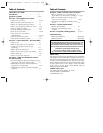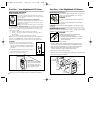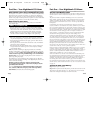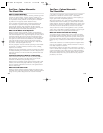
Part One – Your Nighthawk CO AlarmPart One – Your Nighthawk CO Alarm
How to Test Your Alarm (continued)
NOTE: Pressing the Test/Reset button tests the functions of the alarm’s
internal components, circuitry and micro-computer. YOU DO NOT
NEED TO PRESS THE TEST BUTTON TO TAKE A CO READING.
CO readings are automatically shown on the CO alarm’s digital dis-
play. If the alarm shows zero (0), then no measurable amount of CO
has been sensed by the CO alarm within the past 15 seconds.
Testing the Sensor Response
While it is not required, on occasion you may wish to observe and
become familiar with your alarm’s response in the actual presence of
carbon monoxide. The best and safest way to do this is with either a
cigarette or an incense stick. To perform this test you will need: your
CO alarm (that has been powered up for at least two hours), matches
or a butane lighter, an ashtray, and either a cigarette or an incense
stick.
CAUTION: Please refer to the “Frequently Asked Questions” section
for warnings on how NOT to test the sensor response.
WARNING: This test should be done by adults only. Children should
be warned never to light matches or butane lighters. Please use cau-
tion when performing the test described below. Avoid burns from
flame or hot materials. Avoid inhaling excessive smoke from the ciga-
rette or incense stick. Extinguish all flames and properly discard all hot
materials.
Step 1. With a match or a lighter, light a single cigarette or incense
stick. Extinguish the match or lighter. Make sure an ashtray is available
to discard ashes, matches and the burned cigarette or incense stick.
Step 2. Hold the smoldering cigarette or incense stick 12 - 15 inches
directly below the bottom air vents of the CO alarm, making sure the
stream of smoke rises into the vents.
Step 3. Continue holding the cigarette or incense stick directly below
the CO alarm for 3 - 5 minutes, or until you notice a reading on the
display. This time is needed as the CO alarm samples the air every 15
seconds. Note: Do not hold the cigarette or incense stick closer than
12 inches to the CO alarm as smoke will cause a yellow stain to devel-
op on the CO alarm’s outer case.
Step 4. If your unit alarms, you can silence it by pressing the
Test/Reset button and removing the source of CO.
Step 5. Extinguish the cigarette or incense stick by pressing the smol-
dering tip into the ashtray.
How to Know If Your Alarm is Malfunctioning
Your CO alarm performs an internal self-diagnosis every 15 seconds
to make sure that it is functioning properly. The CO alarm is
designed to alert you in the unusual event of a malfunction.
If the CO alarm malfunctions.
In the rare event that your CO alarm malfunctions, it will alert you
with one of these signal groups (depending upon the type of mal-
function that occurs):
Malfunction Signal Group 1 - Component Failure
– An intermittent “chirping” alarm will sound every 30
seconds, and
– An “Err” message will appear on the digital display
OR,
Malfunction Signal Group 2 - Microprocessor Failure
– The alarm will sound continuously, and
– The digital display will be blank, and
– The alarm cannot be shut off by pushing the
“Test/Reset” button
Unplug the CO alarm immediately and return for warranty exchange
(see “Limited Warranty” on back two pages).
What to do if you’re not sure...
PLEASE familiarize yourself with the malfunction alert, and do not
confuse these signals with an alarm. After reading the information
above, if you are still unsure whether your CO alarm is operating
properly, call the KIDDE Safety toll-free consumer hotline at 800-880-
6788 to do a quick diagnostic check of the CO alarm over the phone.
The customer service representative will be able to assist you and
answer your questions.
If your alarm sounder is beeping, and you are not sure if it is a CO
alarm or a malfunction alert, reset the alarm, open windows for venti-
lation, turn off fuel-burning appliances (like kerosene or oil heaters,
furnaces, gas ranges, wood-burning stoves, water heaters, or other
fossil-fuel burning appliances). For furnaces, you can simply turn
down the thermostat to its lowest setting. Open windows and doors
for ventilation. Then call the KIDDE Safety toll-free consumer hotline
at 800-880-6788 for assistance.
Before you call a qualified technician (such as a licensed heating con-
tractor, utility service technician, chimney sweep or fuel provider) to
check your residence for CO, remember that you will probably be
charged for a service call. KIDDE Safety customer service operators
are available to answer your questions and assist you in non-emer-
gency situations at no charge.
1-12
1-11
810-1009 AC Digital 11/13/01 11:22 AM Page 18


















